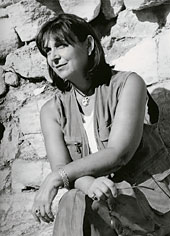“John Sakellarakis’ last big dream and his most favorite excavation was Zominthos which is located half way from the Kalikratian Prefecture of Anogia towards Ideon Andron in an altitude of 1.187 meters”, stressed in an interview to «In-On» magazine, the archaeologist Professor at the University of Athens and honorary curator of antiquities, Mrs. Effie Sakellaraki, wife of the archaeologist-professor John Sakellarakis.
What attracted the attention of the researcher- she continued- was the pre-Hellenic name with the suffix-inthos that a local shepherd from Anogia mentioned referring to the area that he used to graze his sheep. During his visit in the area, at the time of the excavation at Ideon Andron, the miracle was revealed to him. Indeed – as Mrs. Sakellaraki refers – after the decent- with the religious and philosophical meaning – to the sacred cave; Zominthos depicted the ascent to the top world.
More particularly, Mrs. Sakellaraki clarifies that “Zominthos is situated on the spot where the roads towards the big Minoan yet mainly Greek worship center of Ideon Andron are united, namely from north and east where Knossos is located. Probably, this access is the road that Plato in the Laws mentions that leads from Knossos to Ideon Andron. The area was permanently inhabited for 4.000 years, from the Minoan times till today, since significant inhabitation has been noted after the Minoan times in the Mycenaean years, in the Greco-Roman years, in the Byzantine era as well as in the Venetian period, as the so called “venetian creamery” shows and in the ottoman period, too.
Even though, the excavations are in progress, the existence of an extended settlement that started in the 19th century B.C. with an imposing main building with a certified palatial character and the typical “sacred tree” the hawthorn which was declared Monument of Nature demonstrates that it was inhabited by people with exquisite taste that had the organization to cover all their needs”.
According to Mrs. Sakellaraki the main building was about 3 meters tall, with painted rooms, where in some of them the windows and doors still exist whereas in the west part of the building there is the craft wing with a pottery workshop in which a potter’s wheel was found, the position and the tools of the potter and even more in a built construction an amount of filtered dust in order to manufacture stoneware most of which was placed on shelves. There was also a workshop manufacturing rock crystal, a material that exists on Psiloritis Mt. and many objects and mainly beads have been manufactured with it.
Moreover -as Mrs. Sakellaraki mentions- there were found big vases with a magnificent sculptured decoration, lamps, delicate printed vases that indicate people with fine taste. They also collected the hair of the sheep along with other goods of the mountain like minerals, herbs and medical material which constituted along with the woolen clothes, valuable goods for the exportation trade of Knossos and the Minoan Crete not only in the East but in Egypt as well.
Curriculum Vitae
Effie Sakellaraki was born in Piraeus and was brought up in Athens. She is a graduate of the School of Philosophy at the University of Athens (she is a professor at the same school) and of the Industrial School, (Department of Tourism). She attended post-graduate studies in London and Heidelberg. As a scholar of the German Archaeological Institution she wrote two books regarding bronze sculpture in the Aegean Sea. She worked in the Acropolis Museum, in museums in Olympia, Nafplio, Herakleion-Crete, and Corfu and in excavations in the relative areas. She was for many years the Secretary of the excavations of the American School in the Ancient Agora of Athens. She worked in the Civil Registry Monuments Department in the Ministry of Culture and Tourism and in the Department of Underwater Antiquities. It is important to note her participation in the excavation of Zakros, also in the Cretan excavations in Archanes and Zominthos which she co-run with her husband, John Sakellarakis who was an archaeologist, too. Regarding the excavation in Archanes they were awarded by the Academy of Athens, while the prefecture of Archanes proclaimed them Honorary Citizens. Since 1984, and for 15 years she was the curator in the island of Evia where she carried out numerous excavations all over the island, on the island of Skyros and in the Boeotian coast, the findings of which were published. The spotting and the excavation in Kimi on the Viglatouri hill in Oxylinthos are considered one of the most significant Euboean excavations for its importance in the history as well as the detection and the excavation of the pit of the for so many years sought temple of Artemis Amarissia in Amarynthos. After John Sakellarakis’ death she runs the excavation site in Zominthos.
She cooperated in various publications such as the History of the Greek Nation, the international publication of the Mythological Dictionary (LIMC), Enc. Britannica, and Enc. Italiana and wrote almost all the pre-historic articles in the Greek publication of the Soviet Encyclopedia.
She is a member of the Archaeological Society, the Monetary Institution, and the Institute of Underwater Antiquities, the German Archaeological Institute of Berlin, the Archaeological Institute of America and she is also the president of the Psycha foundation.
She has written more than 150 books and articles regarding Minoan Crete, Mycenaean and Cycladic civilizations and Kythira along with issues that regard Evia from the Paleolithic period, the early Greek (Manika in Chalkida etc.), the Mycenaean (Avlida, Lefkadi), the Geometric and Archaic N. Evia (Lichas, Oreoi) till the Classical and Hellenistic Amarynthos. During the last years, she worked together with John Sakellarakis in order to prepare the scientific publication of the Archaeological Society’s excavation in Ideon Andron and the excavation in Zominthos.
Source of publication 15th edition In-On

